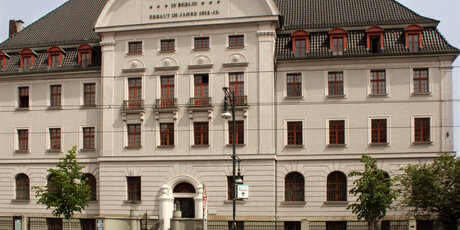Jüdisches Waisenhaus Pankow
Jewish Orphanage of Pankow
The representative building was erected in a neo-baroque style in 1912 by master builder of Berlin’s Jewish Community, Alexander Beer (1873-1944 Theresienstadt), and dedicated in 1913.
This generously decorated orphanage owned a school and a synagogue room with a lavishly decorated, and today restored, coffered ceiling, donated by cigarette manufacturer Josef Garbáty-Rosenthal (1851-1939). In 1906 the businessman had moved his factory from Schönhauser Allee to a property adjacent to the Jewish orphanage. In 1938 the Nazis forced the Garbáty Family to sell all their property. The family emigrated in 1939 to the United States. Josef Garbáty-Rosenthal died that same year in Berlin. The Villa in Berliner Strasse 126/127, in which the Garbáty Family had lived up to 1901, was also “Aryanized”. Bulgaria used the villa an embassy building from 1945 to 1989. In honor of the socially-conscious company founder, in the year 2000 the plaza in front of S-Bahn and U-Bahn stations (opened in 1914 and 2000) were named after Garbáty, in 2002 the monument was dedicated on Garbátyplatz and in 2003 a memorial plaque was inserted in the ground. The orphanage, in which up to 100 children had found a home, was forced to shut down in 1940, seized in 1942 by the SS and in 1943 used as the headquarters for the SS Reich Security Office as a central records facility. Nearly half of all children, teachers and employees who lived and worked in the orphanage at that time were murdered in the death camps in 1942/43. A few of the orphans were able to escape with the help of their teachers. A memorial wall in the library of the former orphanage is a memorial today of the some 600 Jewish citizens of Pankow who were deported and murdered during the Nazi dictatorship. After World War II in 1945, the district administration of Pankow was located in the building, from 1950 the German Sports Federation, from 1952 the Polish and from 1971 to 1991 the Cuban Embassy. The charitable „Dr. Walter and Margarete Cajewitz Foundation“ acquired the empty building in 1999 and had it restored according to historical records. In 2001 the building was re-opened as a meeting place and modern cultural center, with an event room (the former synagogue) and the Janusz Korczak Library (featuring 90,000 media units) open to the public, as well as headquarters for social charities. A charity association entitled “Jewish Orphanage” looks after Jewish cultural sites, researches Jewish life in Pankow and has a memorial in the building. In 2002, Thomas Garbáty, Enkel Josef Garbátys, Maler Alexander Polzin in Israel donated the reconstruction of the wording on the side of the house. The granite sculpture, dubbed the „Stone Dealer“ by writer Thomas Brasch (1945-2001) as a play on words involving „stone“ and „hands“, was created in Israel by painter Alexander Polzin (bronze plaque next to the fence).
